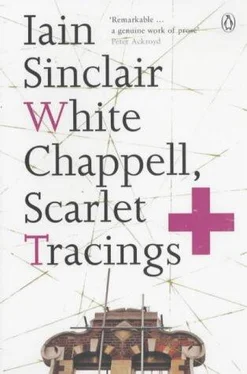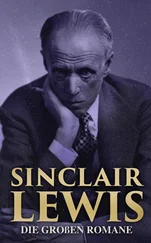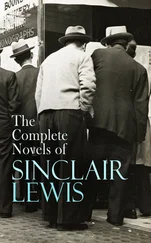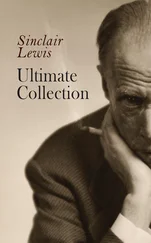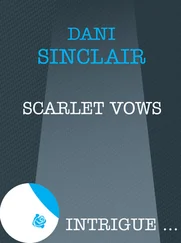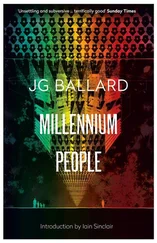‘Dictation at this speed takes the scribe, often under pressure of work or disease, so fast and so deep that he writes it before it happens, and by writing it he causes it to happen, a fate game that allows the unconscious no release. He cannot escape his devils by describing them. The medium does not choose who he will serve.
‘This is to reverse the conventions of detective fiction, where a given crime is unravelled, piece by piece, until a murderer is denounced whose act is the starting point of the narration. Our narrative starts everywhere. We want to assemble all the incomplete movements, like cubists, until the point is reached where the crime can commit itself.
‘That is why there are so many Ripper candidates, so many theories: and they can all be right. They can all fade away in private asylums.
‘The Whitechapel deeds cauterised the millennial fears, cancelled the promise of revelation.’
We needed air: we would walk down to Southwark and examine the surgical tower.
Cobourg Road is a rib from a much older track, the pilgrim way, Old Kent Road, a turn beyond the Becket. This was an area that knew itself, valued itself; but lived with a fear of what was coming, and coming for them. Its secret could be violated: they were existing in suspended time and kept their voices low, made no demands.
Conan Doyle set many of his Sherlockian tales here. In this territory Dr Watson found a wife. The victims of crime awaited its visitation, not yet invaded by the angels of damage; mainline razors, nerve-clipt hatchetheads.
The zone was defended by its rigorous domesticity. The family remained a unit of force within its own walls, related and connected to so many other tribal alignments, van driving uncles, factory workers from the railway caverns: much could be shared, arranged, adjusted, small wrongs seen to. A closeness that was charmed; ordered, ritualised, unspoken. Social workers would unpick it, harm it with care, until it was gone forever.
When the underclothes of the first victim of the Ripper, Mary Ann Nichols, were examined they were found to bear the mark of the Lambeth Workhouse, which led to her identification as the wife of William Nichols, a printer, of Cobourg Road, Camberwell, from whom she had been separated for about nine years. The protection of this enclosure, not being visible or articulated, was erased in gin, burnt out, herself whored, cut loose, sucked inevitably, hauled in, from what she had played at being, down, mindless generosity, servant to Thrawl Street, Fournier, Flower & Dean, another more savage enclosure, the heated intestine of the city: she was slit, drawn out, unmeasured.
We break from this, carelessly. The Surrey Canal has dried; the old cholera line, work ditch, that did for John Gull. The unmarked passage out, to Greenland Dock and the Limehouse Reach, is a track of rubbish, waste, old streets tipped-in to dull its meaning. Maps of futility brought to ground.
There’s nowhere to drink here: the pubs collapsed into their own pretensions, understudy villains ordering up cocktail froth, the mind-destroying jingle of electronic pickpockets.
Southwark holds its time, with the City, with Whitechapel, with Clerkenwell, holds the memory of what it was: it is possible to walk back into the previous, as an event, still true to this moment. The Marshalsea trace, the narrative mazetrap that Dickens set, takes over, the figures of fiction outliving the ghostly impulses that started them. The past is a fiction that absorbs us. It needs no passport, turn the corner and it is with you. The things they do there are natural, you do those things. Detached from this shadow you are nothing, there is nothing. You have no other existence.
Young doctors, with the yelping loudness of Bob Sawyer and Ben Allen, with that exuberance whose post-textual charm does not translate onto the street, shove into The Bunch of Grapes, to drink themselves steady for an afternoon in the cutting-rooms.
We cross St Thomas Street to reach the Red Tower.
A History of Pain under the protection of the cathedral rose: a threading of fruits, cornucopic horns, standing off the subdued brick. We enter, pay our coins, climb.
Under the eaves, the Herb Garret: here are the relics, the Whitechapel bell mortars, where friable bodies are reduced to powder. Here are the names of the Foul Wards; Lazarus, Job, Naples, Magdalen. Here is the warning: ‘The interest of the poor/and their duty/are the same.’ Under low rafters, the seed heads of poppies.
In the preserved operating theatre the light is septic, wound squeezed. The power of pain is honoured: with shavings, hacksaw, table, straps. The solidity of the cutting bench set against the curvature of the ochre galleries, as in Joblard’s room. Above the head of the absent victim a tract is set: ‘Miseratione non mercede’ , to face the audience, the distinguished visitors on their padded chairs.
The floor has been raised three inches on joists to soak up the blood loss.
A paschal lamp hangs, blackened with the concentration of amputees, consciousness screaming with shock, forcing themselves to climb out from the pain, into the tracery of metal, into the light itself.
Long coated surgeons hack and cut, talking their virtuosity into the dry throats of the banked students. Splash the hands with water. A small looking-glass. Their own faces. Beards and teeth. The patients carried out. Performance concluded. The curtain of eyes.
Young Keats, lips bitten, attending. Neophyte. ‘Implicated’ by these rituals in mysteries that made his heart too small to hold its blood. A torrent, that was not to be spoken, speeded by disease: witness.
Pus-spattered high boots, sour veins opened. Men of Guy’s. Gull and Hinton; their private and secure theatre of gesture. Alchemy starts in the entrails of fear: birth-light in dung.
Escape. Heads tip forward, shoulders bruise on the church border: down Cathedral Street, a segmentary glimpse of tower and overhead railway in fractured combination, an expressionist film-set. Pick our way among grape boxes, under the roof-tree of the Borough vegetable market. Choose your entry.
If you can find a working market you’ll find a pub worth drinking in. When the workers are gone — a quiet one.
We approach the Wheatsheaf, ‘TAKE COURAGE’, wheels rattle across the top of the market, a maze of cages; packed carriages run out from the dome of St Paul’s, shuddering.
The bar has its own sense of what it should be: damp wood bowed like whalebone, cabin-close, engravings of the old city, its secret corners, obscure messages. This interior has a narrative quality, like the inside of a pulpit. We have to settle ourselves into a text; nothing is written, everything re-written. We are retrospective. Even the walls are soaked with earlier tales, aborted histories.
Russian stout and blackthorn cider are secured. The rotten vegetable matter scraped from our boots. Sanctuary from the fury of event; discourse spills, like an emptied skull.
But our barman has us in his modest eye, a dangerous fever, recognised, that must be given no opportunity to break out. He swallows the rim of his lips; smooth man, alarmingly smooth, pale glow on him of moths and aspirins, weak coffee; a cupboard golem. His crisp sleeves are pinched up in garter rings; contained smile, like a thirties sex criminal. Face filled with candle-white flesh, a brandy glass of respectable mania. Obsessional cuff twitch. There is no escape from it. He has heard us, he was waiting, we have qualified. Where two men are gathered, a third is always present. Without us he would not be here: without him we could not have come.
I turned my back on the bar and hunched up; he spoke over me, to Joblard, who did not lift his eyes from the table.
‘You mentioned Keats, gentlemen, what do you think of Chatterton?’
Читать дальше
